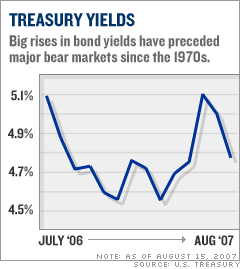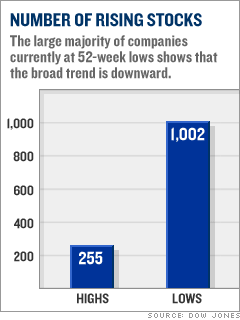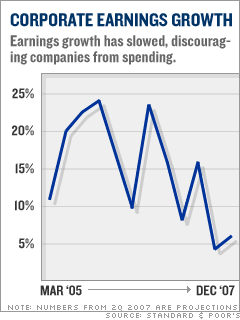Rising energy costs just before the 1990-91 Gulf War were bad news for the market too. That's because when oil becomes much more expensive, one of two things generally happens: stagflation or recession.
Those higher prices act like a tax on the economy, slowing growth. And because higher prices make the Federal Reserve think "inflation!" the Fed typically responds by raising short-term interest rates - something the stock market likes about as much as Nicole Richie likes dessert.
Fast-forward to today: Oil prices are up 20 percent year to date, approaching the record high of $78.40 a barrel.
"You have to expect that these rising oil prices will catch up to businesses and consumers," says Timothy Fidler, a portfolio manager with Ariel Capital.
2.) Treasury yields
Before a bear: Treasury yields often run up
Happened yet? Not really
Happened yet? Not really

Big market pullbacks tend to take place after jumps in the yield of the 10-year Treasury note. Bear markets in the mid-'70s, early and late '80s, early '90s and 2000 all followed significant rises in bond yields. For example, the yield on the 10-year surged from 7 percent in January 1987 to 10.2 percent just before the October crash.
What about now? The 10-year yield rose from about 4.5 percent in mid-March to 5.2 percent in June but dropped back to around 4.7 percent in mid August.
"If the yield on the 10-year went up to 6 percent," says Jeffrey Saut, chief investment strategist for Raymond James Financial, "that could change investor psychology" - and help send the bull packing.
The state of the dollar affects Treasury yields too. A weakening dollar makes foreign investors nervous about holding Treasuries; when they sell, Treasury prices fall and yields rise.
"That would hit stocks, just like in 1987," says Subodh Kumar, an independent market strategist. The dollar has sagged - from $1.29 to the euro at the beginning of the year to $1.34 to the euro in mid August. If it slips further, that's a warning sign, Kumar says.
3.) Number of rising stocks
Before a bear: The number of rising stocks starts to shrink
Happened yet? Has it ever
Happened yet? Has it ever

Before the market crashed in 2000, something fundamental changed. Though the overall indexes (like the Dow and the S&P 500) kept going up, those rises were being fueled by only a handful of companies, mostly Internet-related ones.
The lesson: Sizable increases in just a few stocks can mask what's going on in the broader market and signal that a bull is nearing a top, says Larry Haverty, a portfolio manager with Gamco Investors, an institutional investment firm. So keep an eye on market breadth - that is, how many stocks are rising compared with how many are falling.
If more stocks on the New York Stock Exchange are hitting new 52-week lows than new 52-week highs, that's a bad sign.
In mid-July nearly twice as many stocks were hitting new highs as new lows - a comforting sign - but by month's end this stat had turned downright ugly.
4.) Consumer spending
Before a bear: Consumer spending sometimes slows
Happened yet? Starting
Happened yet? Starting

It stands to reason that when people stop buying stuff, the stock market - populated with companies that sell stuff - heads south. All the major dips in consumer spending over the past 30-plus years have taken place as stocks were just beginning to slide or during prolonged declines.
The tricky part: Measurable drops in consumer spending often occur after the market has already started falling - making it a less than perfect indicator.
It's still important to watch, though, because experts say that slumping consumer spending could help turn what otherwise might have been a mere correction into a true bear.
So far this decade, consumers have been spending away happily - until recently. Retail sales fell 0.9% in June, bad news for companies like Home Depot, Macy's and Sears. And if housing prices continue to drop in many parts of the country, consumers will clutch their pocketbooks still tighter.
Brian Stine, an investment strategist with Allegiant Asset Management Co., a firm that oversees about $30 billion in assets, says, "It could dramatically curb spending and even employment growth." Neither would be good.
5.) Corporate earnings growth
Before a bear: Corporate earnings growth often slows
Happened yet? Just wait for the '07 numbers
Happened yet? Just wait for the '07 numbers

During the bull market of the mid- to late '90s, average earnings for the S&P 500 rose more than 12% a year. When companies began warning of slowing profit growth in 2000, stocks started to nosedive.
Now for the current bull. From 2003 to 2006, the S&P's annual earnings rose more than 17%, on average. But the consensus estimate of the market strategists tracked by Thomson Financial is that earnings will grow by only 7% in 2007 - a huge change.
It's not hard to see why. Productivity growth is down. Wage pressures are rising. And remember those soaring energy prices we just talked about? On top of all that, long-term rates in the first half of the year were sneaking up. If that trend resumes, it will discourage companies from borrowing in order to make big investments.
"If liquidity should dry up," says John Fox, co-manager of the FAM Value fund, "that would be a negative."
Translation: It could make this bull look like hamburger.










